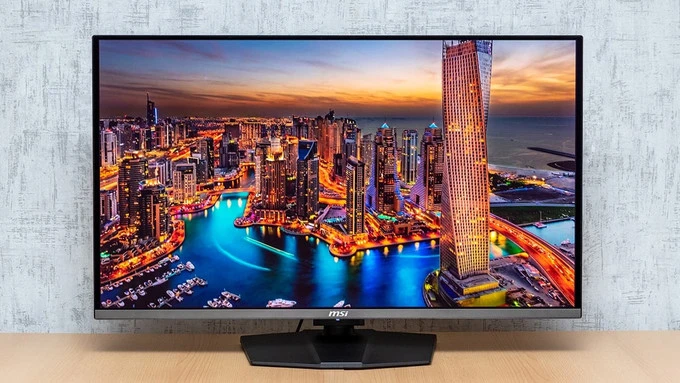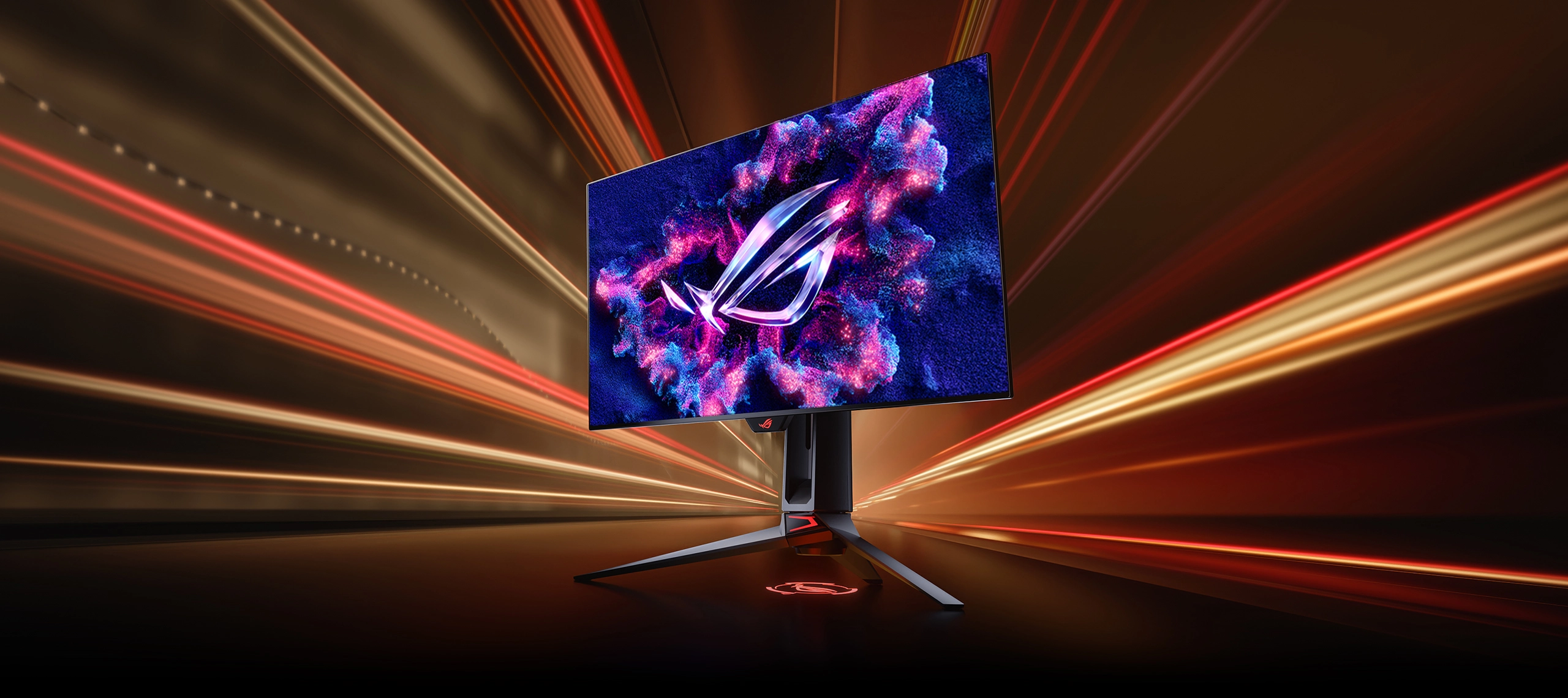
Today, we have a vast array of gaming monitors that cater to gamers' needs across various categories and requirements. OLED availability is finally becoming more accessible and almost a basic need for many users, with refresh rates also increasing to 144 Hz and beyond. Color reproduction is improving, becoming richer, and image lag is minimal—all without a significant hit to your wallet.
When it comes to deciding which gaming monitor to buy in 2025, it can be challenging. Not everyone knows what parameters to focus on or understands the nuances. That's why we've selected top 10 gaming monitors you should consider.
MSI MPG 321URX QD-OLED
~Price $1000
First and foremost, we should highlight the MSI MPG 321URX monitor—it's not just a good device for displaying your computer or console images; it's a true revelation for gamers. While most 32-inch OLED monitors usually cost over $1200, MSI decided to break this rule and offered this display in the $900-1000 price range, without sacrificing what's truly important to many players.
Let's start with the panel: a 32-inch 4K QD-OLED with a staggering 240 Hz refresh rate and an incredibly low response time of just 0.03 ms. The colors are vibrant, blacks are deep, and MSI has addressed OLED's issues with bright room lighting better than most competitors.

Input lag? Virtually nonexistent. Burn-in? Yes, this risk still exists, but MSI has provided protection—and even a 3-year burn-in warranty for peace of mind.
HDR here is decent—MSI MPG 321URX QD-OLED supports DisplayHDR 400 for regular use, and for dramatic moments in games of the relevant genre, there's a peak brightness of 1000 nits. Switching between HDR modes is a bit inconvenient, but this is more of a Windows issue than an MSI device problem.
The design is simple, even somewhat restrained—but at this price, it doesn't matter. You're buying a top-tier OLED gaming monitor that's hundreds of dollars cheaper than similar options. Yes, you'll need to update the firmware and tweak settings out of the box, but once everything is ready, the MPG 321URX will be hard to beat.

LG UltraGear 27GR93U
~Price $500
OLED monitors and displays are currently in the spotlight, but not everyone needs them—not everyone is willing to pay or overpay for them, as they may not be very demanding in this regard. This is where the LG UltraGear 27GR93U comes into play. It's a 27-inch 4K IPS monitor that flawlessly handles basic tasks—and more.
It's one of the sharpest displays on the market thanks to its high pixel density, and LG's factory settings are very successful. Games look rich and vibrant, but not excessively so. Text and interface elements are like under a magnifying glass, making it equally convenient for creative work or content viewing.

The monitor supports a refresh rate of up to 144 Hz—more than enough for modern 4K gaming and competitive games. FreeSync and G-Sync ensure smooth gameplay, and HDMI 2.1 makes it a great option for modern gaming consoles.
HDR? Technically, yes—DisplayHDR 400. It's not impressive but noticeably improves the image in both HDR and SDR. The design is restrained, clean, and thoughtful—with a convenient stand and logical port placement. If you value 4K image quality without compromises and OLED, the 27GR93U is definitely worth considering.

ASUS ROG Strix XG27AQDMG
~Price $700
If you don't need 4K gaming or your budget doesn't quite allow for such luxury, but you want 1440p and everything at once, ASUS offers the ROG Strix XG27AQDMG. This 27-inch glossy OLED monitor is sharp, stylish, and very fast. We're talking about 240 Hz with a response time that virtually eliminates any motion blur.
One of the main features of the monitor is the WOLED panel with Micro Lens Array+ technology. It's really bright, even by OLED standards, and the glossy finish provides deep blacks without the "haze" that matte screens often give. In dark dungeon game locations or on a sunny battlefield, the contrast and detail are simply impressive.

The ASUS ROG Strix XG27AQDMG monitor features built-in support for adaptive sync, minimal input lag, and excellent HDR performance. Thanks to OLED's pixel dimming, you get perfect blacks and bright highlights—arguably the best HDR picture outside of top-tier TVs.
The monitor is priced around $650–700, which isn't a budget option, but it's fair for this level of quality. Support from Nvidia and AMD makes this monitor versatile for any graphics card.
If you need a gaming OLED display with top features at 1440p, the XG27AQDMG is almost unparalleled. It's suitable for esports athletes and those who just want the visual maximum without switching to 4K.

ASUS TUF Gaming VG32VQ1B
~Price $250
Sometimes you just want a big screen with a high refresh rate—and the ASUS TUF VG32VQ1B gives you that without any fuss. It's a 32-inch curved VA monitor with a 1440p resolution, a 165 Hz refresh rate, and a wallet-friendly price.
The 1500R curvature allows for better immersion in the game, and the high refresh rate makes everything smooth—be it movies or dynamic shooters. ASUS added ELMB (Extreme Low Motion Blur) technology, which works even with FreeSync—a rare but valuable combination.

The display's contrast is good for a VA, the viewing angles aren't OLED level, of course, but sufficient for solo gaming or even shooters. Dark scenes give a sense of depth, and the Shadow Boost feature lifts shadows without "blowouts," which can give an advantage in competitions.
HDR10 is also present here, but like most budget options, don't expect true brightness or depth in light areas. However, it does add some "punch" to the image. There are enough ports, the stand is simple but convenient, and the build is quite solid for its price segment.

ASUS ROG Swift PG27AQDP
~Price $1000
While most monitors are limited to a refresh rate of 240 or 360 Hz, the ASUS ROG Swift PG27AQDP raises the bar to an incredible 480 Hz on an OLED panel with a 1440p resolution. This is, without exaggeration, the fastest OLED gaming monitor you can buy today, providing unmatched smoothness for high frame rate games, which is crucial for shooters like CS2, Valorant, APEX Legends, etc.

Despite the extremely high refresh rate, it's still an OLED display—meaning perfectly deep blacks and instant pixel response are guaranteed. ASUS's proprietary ELMB and VRR technologies are also present, preventing flickering and tearing, ensuring crystal-clear images regardless of the game being played.
The PG27AQDP is on a whole other level. Esports athletes and frame rate hunters will definitely appreciate this screen. The only real downside is the price: this is a premium product, and the cost matches its class. But if your goal is to squeeze the maximum out of your PC, this monitor will be a worthy partner.

MSI MPG 341CQPX
~Price $950
The MSI MPG 341CQPX is a breath of fresh air in the 34-inch ultrawide display category. This monitor brought the long-awaited update to QD-OLED panels of this size. For the first time in this segment, we saw a 240 Hz refresh rate, breaking the 175 Hz barrier that had held since 2022. And even that would be enough to impress users, but MSI went further.
This display with a resolution of 3440x1440 offers not only speed but also stunning image quality. The QD-OLED panel has incredible clarity, and the semi-gloss finish handles glare well and avoids the blurred effect that matte WOLEDs sometimes give.

Pixel response time is virtually instantaneous, making it perfect for shooters or competitive games. Thanks to the 21:9 aspect ratio, this monitor is as useful for work as it is for games like Horizon Forbidden West or Cyberpunk 2077, which fully utilize the ultrawide format.
What truly sets this model apart from others is its feature set. It includes USB-C with 90W charging power, a KVM switch for working with multiple systems, and thoughtful OLED burn-in protection—all without any fans.
The only real downside is the older pixel structure of QD-OLED, which makes text clarity somewhat inferior to 27- and 32-inch models. But if you're not too demanding and picky about such moments, this downside can be overlooked.

Samsung Odyssey OLED G93SC
~Price $900
The next candidate for one of the top gaming monitors in 2025 is the ultrawide Samsung G93SC. The monitor is 49 inches wide with a resolution of 5120x1440, equivalent to two 27-inch QHD monitors joined together. This isn't a modest purchase option, as it's not cheap, but for a certain audience that can afford it, it's a true marvel.
This version of the monitor has ditched the Smart TV operating system and multimedia functions that were more of a hindrance than a help in the previous G95SC. Instead, you get pure gaming performance: a 240 Hz refresh rate, a comfortable 1800R curvature, and one of the brightest QD-OLED panels. It's the perfect choice for racing simulators, flight sims, or RPGs that only get better with cinematic imagery.

Despite the enormous screen size, image clarity remains high thanks to the second-generation QD-OLED with improved pixel structure. There are convenient additions: support for picture-by-picture mode, fairly good built-in speakers, and numerous customization modes for different genres.
It may not be the best monitor for work—text isn't as clear, and older games may not scale correctly—but if you're looking for a monitor for maximum gaming immersion, the G93SC will give you that effect.

KOORUI GN02
~Price $170
Not everyone is ready to spend thousands on top computer monitors, and this is where the KOORUI GN02 comes in. For under $200, you get a 27-inch 1080p display with a 240 Hz refresh rate, low response time, and a performance-focused approach. It's not just a budget option—it's a smart investment worth every penny.
The design is simple and functional, clearly aimed at achieving the best price. Inside, the GN02 impresses: AMD FreeSync ensures smooth gameplay, the VA panel provides good contrast and surprisingly rich colors. It's not OLED, but for this price range, the quality far exceeds expectations.

For first-person shooters, this monitor excels, providing quick response for competitive games. There are no conveniences like USB hubs or stand adjustments, and 1080p on 27 inches may look a bit blurry.
But if you're interested in gaming performance at the lowest price, the GN02 is an extremely attractive option on the market for its price and quality.
AOC 24G4
~Price $120
AOC 24G4 is among top rated gaming monitors. For fans of esports and competitive games, we can offer a 24-inch monitor with a 1080p resolution and a 1 ms response time, perfect for games like Valorant or CS2.
The AOC 24G4 is a somewhat simple monitor that doesn't sacrifice quality. You get a quality IPS panel, excellent motion handling, and gamer features like crosshair settings and gaming modes that change colors and sharpness in real-time. There is also flicker-free technology that reduces eye strain during long sessions.
Brightness and contrast aren't impressive, and the stand has limited adjustments. This is to be expected at this price, as something has to be sacrificed. But the image is stable, without artifacts or blowouts, and the price is perfect for those just starting to dive into serious gaming.

Samsung Odyssey G5 34
~Price $300-400
If you want to try the ultrawide monitor format but aren't ready for a 49-inch monster or significant financial losses, the Samsung Odyssey G5 34 is a good compromise. It features a 3440x1440 VA panel with a 1000R curvature. While it's not as bright as Samsung's OLED monitors, it still offers decent immersion and good performance.

The Samsung Odyssey G5 34 monitor offers a 165 Hz refresh rate and a 1 ms response time, providing smooth and responsive gameplay in dynamic action games with shootouts and solo games like Elden Ring or Spider-Man: Miles Morales, where atmosphere is more important than millisecond precision. High contrast is a strong point of this model, especially in dark scenes in a dimly lit room.
Weak points can be noticed if you expect more from HDR or want to seriously work with multiple windows. HDR support is basic, and color coverage is insufficient for demanding users. There are also nuances with variable refresh rates, and the stand isn't very flexible. However, overall, it's a solid monitor that provides an excellent balance between capabilities and price.






Comments1